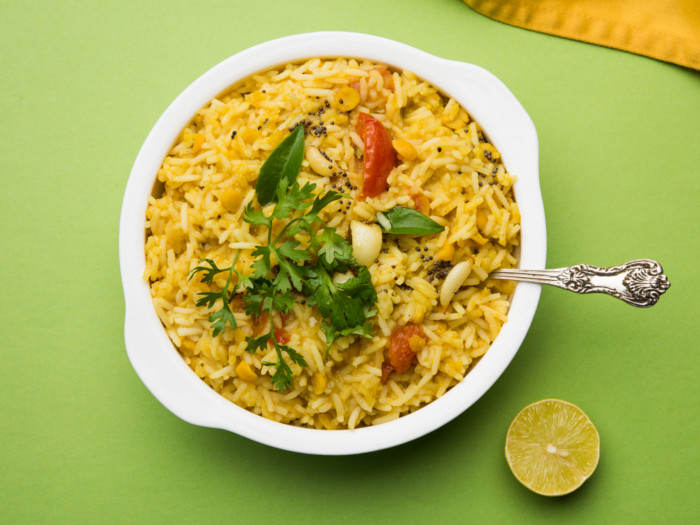The nutritional health benefits of khichdi, a traditional Indian comfort food made of rice, lentils, and turmeric, include its ability to nourish the body, aid in digestion, lower cholesterol, and boost heart health. It is an important part of an Ayurvedic diet as it is a simple, wholesome, and nutritious meal that contains a combination of macro-nutrients such as carbohydrates, protein, and fiber. Khichdi also contains essential vitamins and minerals such as vitamin C, vitamin B complex, magnesium, potassium, calcium, and phosphorus.
What is Khichdi?
Khichdi or khichadi is an Indian porridge-like blend that is made by cooking rice, green or yellow lentils, turmeric, cumin, clarified butter (ghee), and salt in a pre-heated large pot. It can be had plain or with minimal spices. This humble dish has gained popularity internationally because of its powerful medicinal properties.
In India, khichdi is often given to babies as it is easily digestible and nourishing. Most doctors recommend this dish as the ‘go-to’ food to people when they have digestive problems, fever, or are in poor health. To put it simply, the importance of this dish in an Indian’s life is perhaps the same as that of chicken soup in an American’s life. [1]

Call it by any name, a khichdi is just about the greatest Indian comfort food ever invented. Photo Credit: Shutterstock
Khichdi Health Benefits
The nutritional benefits of khichdi are as follows :
Wholesome & Nutritious Meal
The rice and lentil combination in khichdi may help give the right mix of carbohydrates, dietary fiber, and protein. This gluten-free simple vegetarian meal has all 10 essential amino acids, making it a complete protein source. According to the USDA National Nutrient Database, white rice is packed with essential vitamins and minerals such as vitamin B, potassium, phosphorus, folic acid, and manganese. Lentils, on the other hand, are0 also power-packed with protein and similar minerals and vitamins. [2] [3] [4]
May Aid in Digestion
Cumin used in khichdi aids in digestion by possibly increasing the activity of digestive enzymes in the body. This spice also releases bile from the liver, which helps in the digestion of fats and certain nutrients in the gut. Furthermore, the consumption of khichdi may help detoxify the system which keeps the digestive system in order and helps promote weight loss.
Possibly Anti-inflammatory
Turmeric, used in khichdi, is known for its potent anti-inflammatory properties. Turmeric contains curcumin and aids in relieving arthritis pain. The spice contains bioactive compounds with powerful medicinal properties that increase the antioxidant capacity of the body whilst improving brain function. In the ‘Turmeric, the Golden Spice’ chapter of Herbal Medicine: Biomolecular and Clinical Aspects, it is stated that turmeric is a well-documented treatment for various respiratory conditions such as asthma, bronchial hyperactivity, runny nose, cough, and sinusitis. It may also helps treat allergies, liver disorders, anorexia, rheumatism, and helps heal diabetic wounds. [5] [6]
May Reduce Blood Sugar Levels
Lentils used in khichadi can significantly reduce blood sugar levels. A 2018 study published in the Journal of Nutrition stated that replacing half of your portion with lentils can lower your blood glucose levels by more than 20 percent and improve your body’s response to carbohydrates, benefiting people with diabetes. [7]
Might Boost Heart Health
Lentils are possibly rich in polyphenols which may have the ability to lower blood pressure and help prevent various cardiovascular diseases. According to an NIH study, lentils administered to laboratory animals showed that it actively reduced the total cholesterol, LDL or bad cholesterol, and triglyceride levels. The study recommended that lentils should be consumed on a regular basis as it has the potential to reduce the risk of coronary artery diseases. [8]
Possibly A Great Source of Macro-nutrients
Freshly prepared khichdi is usually eaten with clarified butter (pure cow’s ghee), which is a great source of macro-nutrients, protein, complex carbohydrates, and fat. Hari Sharma, a researcher at the Center for Integrative Medicine and Department of Pathology, The Ohio State University, USA, calls ghee the healthiest source of edible fat that promotes longevity, strengthens the brain and nervous system, and lubricates the connective tissues and joints. If you were to add vegetables to it, it would further add to the nutritional component. [9]
Possibly Gluten-free
Another advantage of eating khichdi is that it is possibly gluten-free, which is beneficial for people who suffer from gluten sensitivity or celiac disease. Celiac disease gives rise to a number of gastrointestinal symptoms. Patients who have substantial and rapid symptoms of the disease should thus opt for a gluten-free diet, such as khichdi, as it will aid in their weight loss and also prevent ailments like diarrhea and steatorrhea. [10]
